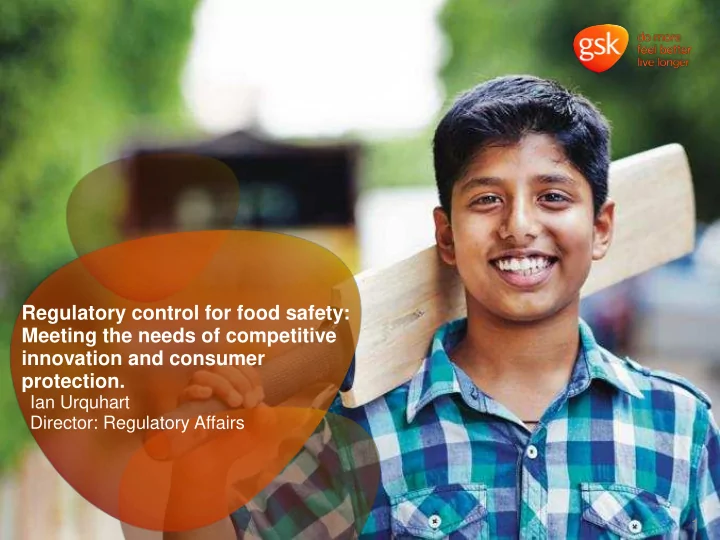

Regulatory control for food safety: Meeting the needs of competitive innovation and consumer protection. Ian Urquhart Director: Regulatory Affairs 1
Agenda 1. Innovation‟s contribution to consumers 2. From foods to pharma – a perspective of risk / benefit 3. How risk assessment and management practices are sometimes perceived 4. Ideas / examples for good practice 2
The GSK India product portfolio Helping people to do more, feel better, live longer 3
Innovation is the lifeblood of any sustainable business Innovate or decline … and for Fast Moving Consumer Goods … Innovate fast Profit Total Profits Profit D required from C Innovation B E Profit from Contribution to profit products from Product A A to E Year 2 4 6 Great innovation has delivered a diverse range of food products to Indian consumers; the processed food industry has grown dramatically
The majority of responsible food business operators want do the right things, and do things right - to retain consumer trust Consumer/user needs & segments Political, regulatory & Brand proposition environmental factors & story Products Manufacturing, process technology & IP Innovation + sourcing distribution Space™ Business models Competitors & and value drivers competing technologies Channels & countries Innovation Space is a trade mark of Viadynamics Ltd 5 www.viadynamics.com
Innovation needs to operate in an environment that does not treat all risks as equal – because they are not …. Borderline between Borderline between Food – foods / medicines Cx / Rx medicines Drugs – important therapeutic nutrients, window, maintenance adverse side Consumer of healthy effects, Patients Consumers lifestyle, Self-selection treatment / or OTC history of safe cure of use, frequent disease; consumption “consumed” for nutrition / for therapy pleasure Necessary for life; Benefit Track record of safety – risks associated outweighs with environment detriment risks do exist and frequency of consumption Trust = Management / Control Risk 6
Many positive examples of proportionate control systems in many countries - that help deliver innovation 1. Shift in international food control systems from „command and control‟ to systems based on risk analysis and prevention 2. Move away from emphasis on end product inspection, approval and testing to preventive control of hazards and implementation of certification systems 3. Regulators implement preventive systems based on scientific evidence of unacceptable health risks, and mandate application of preventive programmes (such as HACCP). 7
Inappropriate risk assessment and management practices can undermine the trust of the key stakeholders Too slow; not time bound; delays Lack of clear requirements No opportunity for dialogue; to explain and listen Treat all risks the same; with the same priority Not another food scare ….. ! Who No transition periods for change; can I trust ? high costs of rework Don‟t deal with non - Not focused on the compliance; no level science; emerging playing field risks 8
The negative impact of inappropriate control on competitive innovation and risk management is substantial 1. Resources focused on treating all ingredients / products as the same risk can dilute valuable resource - away from the high risks 2. Unresponsive management practices run the risk of being perceived as • Burdensome • Inefficient to the needs of a rapidly changing global environment – to deal with emerging risks and consumer demands 3. Regulatory control systems are a factor in commercial strategies and investment decisions 9
What risk management strategy would help deliver fast sustainable innovation in India ? Avoiding these potential And leveraging ... issues … Poor perceptions (or realities) of Shared values (focused on the process consumer protection) Lack of harmonisation International best practice Lack of clarity / certainty Science & technology to retain the trust of consumers and all process stakeholders 10
Perhaps the strategic answer is … 1. Not only about what you choose to do, but also about what you choose not to do … 2. Recognition that each stakeholder delivers a unique set of “services” …. What “attributes” valued by consumers / citizens are unique to your organisation ? • Innovation – Industry • Risk assessment – Scientists • Risk management – Regulator • Enforcement System – Courts, etc. 3. Communication between stakeholders helps to deliver a proportionate management system 11
Some characteristics of risk management system to deliver quality, safety & rapid innovation • Certify a business to manufacture (or import) a certain class of product • Limited regulator intervention with well-established safety In the event submissions are need to assess novel (ingredients, technologies) • Efficient handling of assessments • A predicable regulatory environment – type of data, review timings • Clear process for interactions & “stop the clock” procedures • Dialogue / guidance before, during and after assessment 12
Even the drug processes are proportionate, and use clear guidance, dialogue and targets to help deliver efficient innovation What helps in the drug approval process? The Pharmaceutical Product Lifecycle • Clear guidelines (ICH) Pre-IND • Pre-submission meetings Synthesis and purification Animal and laboratory testing • Targets for New Drug Pre-IND agency meeting Application reviews IND submitted • Use of abridged IND phases Clinical Phase I applications Clinical Phase II • Clinical and Toxicological End of Phase II Agency Meeting Clinical phase III testing is frequently Pre-NDA agency meeting NDA submitted waived for generic active ingredients NDA Review and Approval • OTC status for Post Approval – Phase IV clinicals molecules with well established safety 13
Conclusion 1. We share the same values 2. Change is certain – innovation responds to unmet consumer needs and drives change 3. “How” to manage risk is context specific – regulator approaches from elsewhere can be positive or negative – no single attribute (or set) makes a process work 14
Recommend
More recommend